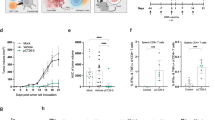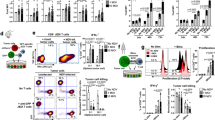Abstract
Dendritic cells (DCs) are highly efficient antigen-presenting cells capable of priming both cytotoxic and helper T cells in vivo. Recent studies have demonstrated the potential use of DCs that are modified to carry tumor-specific antigens in cancer vaccines. However, the optimal administration route of DC-based vaccines to generate the greatest anti-tumor effect remains to be determined. This study is aimed at comparing the levels of immune responses and anti-tumor effect generated through different administration routes of DC-based vaccination. We chose the E7 gene product of human papillomavirus (HPV) as the model antigen and generated a stable DC line (designated as DC-E7) that constitutively expresses the E7 gene. Among the three different routes of DC-E7 vaccine administration in a murine model, we found that intramuscular administration generated the greatest anti-tumor immunity compared with subcutaneous and intravenous routes of administration. Furthermore, intramuscular administration of DC-E7 elicited the highest levels of E7-specific antibody and greatest numbers of E7-specific CD4+ T helper and CD8+ T cell precursors. Our results indicate that the potency of DC-based vaccines depends on the specific route of administration and that intramuscular administration of E7-transfected DCs generates the most potent E7-specific anti-tumor immunity.
This is a preview of subscription content, access via your institution
Access options
Subscribe to this journal
Receive 12 print issues and online access
$259.00 per year
only $21.58 per issue
Buy this article
- Purchase on Springer Link
- Instant access to full article PDF
Prices may be subject to local taxes which are calculated during checkout








Similar content being viewed by others
References
Steinman RM . The dendritic cell system and its role in immunogenicity (review) Annu Rev Immunol 1991 9: 271–296
Cella M, Sallusto F, Lanzavecchia A . Origin, maturation and antigen presenting function of dendritic cells (review) Curr Opin Immunol 1997 9: 10–16
Hart DN . Dendritic cells: unique leukocyte populations which control the primary immune response Blood 1997 90: 3245–3287
Romani N et al. Presentation of exogenous protein antigens by dendritic cells to T cell clones. Intact protein is presented best by immature, epidermal Langerhans cells J Exp Med 1989 169: 1169–1178
van Kooten C, Banchereau J . Functional role of CD40 and its ligand (review) Int Arch Allerg Immunol 1997 113: 393–399
Pierre P et al. Developmental regulation of MHC class II transport in mouse dendritic cells Nature 1997 388: 787–792
Cella M et al. Inflammatory stimuli induce accumulation of MHC class II complexes on dendritic cells Nature 1997 388: 782–787
Austyn JM . New insights into the mobilization and phagocytic activity of dendritic cells J Exp Med 1996 183: 1287–1292
Mayordomo JI et al. Bone marrow-derived dendritic cells pulsed with synthetic tumour peptides elicit protective and therapeutic antitumour immunity Nature Med 1995 1: 1297–1302
Ossevoort MA et al. Dendritic cells as carriers for a cytotoxic T-lymphocyte epitope-based peptide vaccine in protection against a human papillomavirus type 16-induced tumor J Immunother Emph Tumor Immunol 1995 18: 86–94
Mayordomo JI et al. Bone marrow-derived dendritic cells serve as potent adjuvants for peptide-based antitumor vaccines (review) Stem Cells 1997 15: 94–103
Rouse RJ et al. Induction in vitro of primary cytotoxic T-lymphocyte responses with DNA encoding herpes simplex virus proteins J Virol 1994 68: 5685–5689
Tuting T, DeLeo AB, Lotze MT, Storkus WJ . Genetically modified bone marrow-derived dendritic cells expressing tumor-associated viral or ‘self’ antigens induce antitumor immunity in vivo Eur J Immunol 1997 27: 2702–2707
Arthur JF et al. A comparison of gene transfer methods in human dendritic cells Cancer Gene Ther 1997 4: 17–25
Dietz AB, Vuk-Pavlovic S . High efficiency adenovirus-mediated gene transfer to human dendritic cells Blood 1998 91: 392–398
Dranoff G et al. Vaccination with irradiated tumor cells engineered to secrete murine granulocyte–macrophage colony-stimulating factor stimulates potent, specific, and long-lasting anti-tumor immunity Proc Natl Acad Sci USA 1993 90: 3539–3543
Nair SK, Snyder D, Rouse BT, Gilboa E . Regression of tumors in mice vaccinated with professional antigen-presenting cells pulsed with tumor extracts Int J Cancer 1997 70: 706–715
Yang S, Darrow TL, Vervaert CE, Seigler HF . Immunotherapeutic potential of tumor antigen-pulsed and unpulsed dendritic cells generated from murine bone marrow Cell Immunol 1997 179: 84–95
Ashley DM et al. Bone marrow-generated dendritic cells pulsed with tumor extracts or tumor RNA induce antitumor immunity against central nervous system tumors J Exp Med 1997 186: 1177–1182
Shen Z, Reznikoff G, Dranoff G, Rock KL . Cloned dendritic cells can present exogenous antigens on both MHC class I and class II molecules J Immunol 1997 158: 2723–2730
Tatsuka M, Orita S, Yagi T, Kakunaga T . An improved method of electroporation for introducing biologically active foreign genes into cultured mammalian cells Exp Cell Res 1988 178: 154–162
Lin KY et al. Treatment of established tumors with a novel vaccine that enhances major histocompatibility class II presentation of tumor antigen Cancer Res 1996 56: 21–26
Feltkamp MC et al. Vaccination with cytotoxic T lymphocyte epitope-containing peptide protects against a tumor induced by human papillomavirus type 16-transformed cells Eur J Immunol 1993 23: 2242–2249
Tindle RW, Fernando GJ, Sterling JC, Frazer IH . A ‘public’ T-helper epitope of the E7 transforming protein of human papillomavirus 16 provides cognate help for several E7 B-cell epitopes from cervical cancer-associated human papillomavirus genotypes Proc Natl Acad Sci USA 1991 88: 5887–5891
Morse MA et al. Migration of human dendritic cells after injection in patients with metastatic malignancies Cancer Res 1999 59: 56–58
Eggert AA et al. Biodistribution and vaccine efficiency of murine dendritic cells are dependent on the route of administration Cancer Res 1999 59: 3340–3345
Banchereau J, Steinman RM . Dendritic cells and the control of immunity Nature 1998 392: 245–252
Germain RN . MHC-dependent antigen processing and peptide presentation: providing ligands for T lymphocyte activation (review) Cell 1994 76: 287–299
Inaba K et al. Tissue distribution of the DEC-205 protein that is detected by the monoclonal antibody NLDC-145. 1: Expression on dendritic cells and other subsets of mouse leukocytes Cell Immunol 1995 163: 148–156
Ji H et al. Targeting HPV-16 E7 to the endosomal lysosomal compartment enhances the antitumor immunity of DNA vaccines against murine HPV-16 E7-expressing tumors Hum Gene Ther 1999 10: 2727–2740
Acknowledgements
The immortalized dendritic cell line is a kind gift from Dr Kenneth L Rock. We thank Yan-Qin Yang and Hai-Yan Chen for their excellent technical assistance. We thank Lee Wu for her assistance in statistical analysis. This work was supported by NIH 5 PO1 34582–01, U19 CA72108–02, RO1 CA72631–01, Cancer Research Institute, the Richard W TeLinde fund and the Alexander and Margaret Stewart Trust grant.
Author information
Authors and Affiliations
Rights and permissions
About this article
Cite this article
Wang, TL., Ling, M., Shih, IM. et al. Intramuscular administration of E7-transfected dendritic cells generates the most potent E7-specific anti-tumor immunity. Gene Ther 7, 726–733 (2000). https://doi.org/10.1038/sj.gt.3301160
Received:
Accepted:
Published:
Issue Date:
DOI: https://doi.org/10.1038/sj.gt.3301160
Keywords
This article is cited by
-
Immunotherapies landscape and associated inhibitors for the treatment of cervical cancer
Medical Oncology (2023)
-
Local radiotherapy and E7 RNA-LPX vaccination show enhanced therapeutic efficacy in preclinical models of HPV16+ cancer
Cancer Immunology, Immunotherapy (2022)
-
TLR9 acts as a sensor for tumor-released DNA to modulate anti-tumor immunity after chemotherapy
Journal for ImmunoTherapy of Cancer (2019)
-
Activities of stromal and immune cells in HPV-related cancers
Journal of Experimental & Clinical Cancer Research (2018)
-
Enhancing antitumor immunogenicity of HPV16-E7 DNA vaccine by fusing DNA encoding E7-antigenic peptide to DNA encoding capsid protein L1 of Bovine papillomavirus
Cell & Bioscience (2017)



